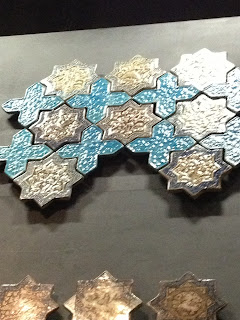The tile art was ceramic glaze dated from Iran 1266-1267. I choose this because I wanted to do something different than painting, I felt like the challenge was going to be how to place it in a similar way to a representational image that already had a narrative.
I was attracted to the Iranian art area because of my internship with Kohl's. I felt like I should take the chance to look at some of the pieces of great iranian art while I had the chance. Initially there seemed to be more of a reverence for the art in the Islamic art are of the museum than that of the rest of the museum. I stumbled upon it while looking at the Mediterranean art and then suddenly the room I was walking through opened up into a balcony that overlooked the Islamic exhibit. The exhibit had a decidedly hushed murmur about it. People were walking around slowly and taking their time as they moved through the planned gallery space. All were seemingly more careful, quiet, and considerate compared to the more popular areas of the museum exhibit where crowds gawked, gathered, and exclaimed.
The exhibit area for the Islamic Art display really demonstrates the conscious decision making that went into it. The area is newly constructed, in fact this spring is the first time the area is open to visitors. The space was largely dominated by the colorful tapestries that flanked the right side of the exhibit as well as the display cases set at 45 degree angles along the floor perpendicular to the balcony style entrance I emerged from. The height of the balcony allowed me to look over the space and take in the various blocks of displays gathering interest. However, immediately my gaze was drawn directly to the wall opposite me, directly in the back of the room. Even among all the display cases, tapestries, and people I was able to spot a bright area of color (even brighter, it seemed, than the rest of the things in the room although that is hard to imagine). I moved toward the back of the room and directly toward the mosaic tile I choose.
The perimeter of the mosaic piece I choose was clear to be intentional. The wall it hung on was painted a black slate but the piece itself and the ones which surrounded it were colorful and highly noticeable from a distance so their placement within the space utilized this to their advantage, drawing attending from people despite its location at the “back” of the gallery. On the same wall there are a mix of other eight sided stars, but the ones I chose to study were the only ones without other illustrations or depictions on the stone.
Key parts of my experience while in the Islamic Art section was the congruency between the tile and the work presented. Gold and wood inlay mixed with color stain was a prevalent part of the exhibit as a whole. When I moved to sit on the floor in front of my piece I was immediately drawn to the floor. The well planned out design did not overlook the floor, it brought gold flecks and lines into black slate floor which mimicked the arabic writing that presented itself throughout the decor work.
 |
| Rough Sketch up of the layout of the room |
 |
| Rough look at the piece and notes |
 |
| Some more tiny notes |


No comments:
Post a Comment